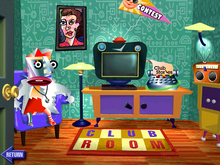- Club Kidsoft
-
Contents
Overview
KidSoft Inc. was an educational software company based in Los Gatos, CA. It was started in May 1992 by Richard Devine and Charles Patterson, and subsequently managed by Howard Blumenthal (formerly the creator/producer of PBS series, Where in the World Is Carmen Sandiego and Dan'l Lewin (formerly head of educational marketing for Apple Computer), and Lucia Steinhilber.
In its heyday, Club Kidsoft was a quarterly kid's magazine and CD-ROM disc, focusing on educational software. It was the first computer magazine for kids, and ultimately reached a circulation of over 100,000. As a result, KidSoft introduced many households to the idea of computing for children. The magazine was published at a time when Oregon Trail, Reader Rabbit, Carmen Sandiego, Print Shop, and other kid-friendly products were developed and published by entrepreneurial software firms specializing in original children's software. This phenomenon lasted only a few years; it was soon overwhelmed by licensed products from Disney and other large firms.
The combined magazine and CD-ROM had an annual subscription cost of $15.95 (USD). Soon after launch, the magazine and the catalog were separated. The reworked magazine featured articles and activities related to children's use of computers; these were supported by KidSoft-produced activities on the CD-ROM.
In an effort to increase its subscriber base, KidSoft signed deals to bundle the CD-ROM portion of its magazine with new Apple Performas and Compaq Presarios.
Context
At the time that KidSoft was in operation, many parents were uncertain about the role of a computer in a family household. There were online services, but no internet. There were some computer games, but only a small number of titles suitable for children. The purpose of KidSoft was simple: to encourage parents to think about computing as a meaningful aspect of childhood. Hardware manufacturers liked the idea (Compaq was an early investor) because KidSoft provided access to the challenging market of young parents. Software manufacturers, whose distribution was, largely, through schools and specialty retailers, supported the concept because KidSoft provided a direct means to sell to parents and families (more so because KidSoft's magazine created a fun environment that encouraged children to use the computers and to care about the new software). Families trusted KidSoft because the company tested every product it sold, and helped parents to make age- and curriculum-appropriate software decisions for children. In time, parents learned to accept computing as a part of a child's education. The extent to which KidSoft affected this social change may be debated, but it seemed to play a role in many households.
Magazine
In its initial form, the magazine portion was divided into two parts. The first third was filled with content aimed at kids such as puzzles, mazes, games and paper airplanes. The remaining two-thirds was normally a catalog of the games available on the CD-ROM which came with the magazine. Later, the magazine and the catalog were separated, allowing KidSoft to become an advertiser-supported children's magazine about computers, and the catalog to become a standalone mail order catalog filled with "kid-tested, parent-approved" software for the first generation of computing kids.
CD-ROM
The CD-ROM was an enhanced CD which was both a data and audio hybrid, unique because it contained "locked" versions of software that could be purchased directly from the disk (using an "unlock code" available from KidSoft). The CD-ROM also contained activities for "club members" (anyone who owned or used the CD). The remaining portion of the CD-ROM was an interactive software catalog with about forty software titles, none of which were made by Kidsoft. The catalog included a picture of the game's box, a brief description of the game, awards won by the game (if any), reviews, system requirements and sometimes also a demo of the game. Some demos were interactive while others were multimedia slideshows with pictures from the game. Many more demos then were linked through the launcher could be played directly in the Demos directory on the CD-ROM.
Two versions of the software were available for either Apple Macintosh, or Microsoft Windows. The audio portion had music and announcements from Club Kidsoft. The software portion of the CD-ROM was devoted to kid contributed content such as paintings and written stories. Software could be purchased by calling the company and paying with a credit card number. The service representative would then provide a unique serial number which could be typed into the launcher program. Once verified this would allow the full version of the purchased game to be installed. This action is provided through a specially coded program generated by the installer, which behaved like a disc image mounting utility - correct unlock codes allowed the utility to unencrypt and mount the contents from the disc images as part of the CD-ROM's internal structure. It was a Control Panel program on Macintosh computers and a terminate-and-stay-resident driver on Windows computers.
Business
Originally conceived as a means to sell floppy-disk software through CD-ROMs, the company lost its initial advantage when publishers began to produce larger programs that required one or more CD-ROMs per product. This led to an emphasis on catalog marketing, which placed KidSoft in competition with larger brick-and-mortar retailers. KidSoft experimented with various retail formats, ultimately settling upon a discounted spinner rack merchandising scheme that eliminated the need for the club, the membership, the magazine, and many of the company's original components.
Along the way, KidSoft was a major innovator. The company produced one of AOL's first retail stores, and set the standard for a very early version of -e-commerce and branding of digital media.
KidSoft was acquired by Hearst Corporation, which distributed the magazine for a brief period. In time, KidSoft ceased publication of the magazine, and then, ceased its software distribution activities. During its final year, KidSoft was reworked as a low-priced retail brand for older children's software.
Categories:- Defunct educational software companies
- Companies established in 1992
Wikimedia Foundation. 2010.


